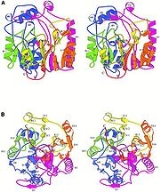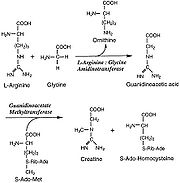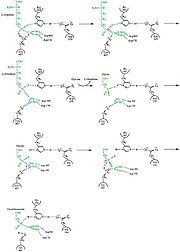
Arginine:glycine amidinotransferase
Encyclopedia


Enzyme
Enzymes are proteins that catalyze chemical reactions. In enzymatic reactions, the molecules at the beginning of the process, called substrates, are converted into different molecules, called products. Almost all chemical reactions in a biological cell need enzymes in order to occur at rates...
that catalyses the transfer of an amidino group from L-arginine
Arginine
Arginine is an α-amino acid. The L-form is one of the 20 most common natural amino acids. At the level of molecular genetics, in the structure of the messenger ribonucleic acid mRNA, CGU, CGC, CGA, CGG, AGA, and AGG, are the triplets of nucleotide bases or codons that codify for arginine during...
to glycine
Glycine
Glycine is an organic compound with the formula NH2CH2COOH. Having a hydrogen substituent as its 'side chain', glycine is the smallest of the 20 amino acids commonly found in proteins. Its codons are GGU, GGC, GGA, GGG cf. the genetic code.Glycine is a colourless, sweet-tasting crystalline solid...
. The products are L-ornithine
Ornithine
Ornithine is an amino acid that plays a role in the urea cycle.-Role in urea cycle:L-Ornithine is one of the products of the action of the enzyme arginase on L-arginine, creating urea. Therefore, ornithine is a central part of the urea cycle, which allows for the disposal of excess nitrogen....
and glycocyamine
Glycocyamine
Glycocyamine is a metabolite of glycine in which the amino group has been converted into a guanidine.Glycocyamine is a direct precursor of creatine and is used as a supplement. However the metabolism of creatine from glycocyamine in the liver causes a depletion of methyl groups...
, also known as guanidinoacetate, the immediate precursor of creatine
Creatine
Creatine is a nitrogenous organic acid that occurs naturally in vertebrates and helps to supply energy to all cells in the body, primarily muscle. This is achieved by increasing the formation of Adenosine triphosphate...
. Creatine and its phosphorylated form play a central role in the energy metabolism of muscle and nerve tissues. Creatine is in highest concentrations in the skeletal muscle, heart, spermatozoa and photoreceptor cells. Creatine helps buffer the rapid changes in ADP
Adenosine diphosphate
Adenosine diphosphate, abbreviated ADP, is a nucleoside diphosphate. It is an ester of pyrophosphoric acid with the nucleoside adenosine. ADP consists of the pyrophosphate group, the pentose sugar ribose, and the nucleobase adenine....
/ATP
Adenosine triphosphate
Adenosine-5'-triphosphate is a multifunctional nucleoside triphosphate used in cells as a coenzyme. It is often called the "molecular unit of currency" of intracellular energy transfer. ATP transports chemical energy within cells for metabolism...
ratio in muscle and nerve cells during active periods. Creatine is also synthesized in other tissues, such as pancreas
Pancreas
The pancreas is a gland organ in the digestive and endocrine system of vertebrates. It is both an endocrine gland producing several important hormones, including insulin, glucagon, and somatostatin, as well as a digestive organ, secreting pancreatic juice containing digestive enzymes that assist...
, kidney
Kidney
The kidneys, organs with several functions, serve essential regulatory roles in most animals, including vertebrates and some invertebrates. They are essential in the urinary system and also serve homeostatic functions such as the regulation of electrolytes, maintenance of acid–base balance, and...
s, and liver
Liver
The liver is a vital organ present in vertebrates and some other animals. It has a wide range of functions, including detoxification, protein synthesis, and production of biochemicals necessary for digestion...
, where amidinotransferase is located in the cytoplasm
Cytoplasm
The cytoplasm is a small gel-like substance residing between the cell membrane holding all the cell's internal sub-structures , except for the nucleus. All the contents of the cells of prokaryote organisms are contained within the cytoplasm...
, including the intermembrane space
Intermembrane space
The intermembrane space also known as IMS is the region between the inner membrane and the outer membrane of a mitochondrion or a chloroplast. The main function of the intermembrane space is oxidative phosphorylation....
of the mitochondria, of the cells that make up those tissues.
Function
L-Arginine:glycine amidinotransferase catalyses the first, which is also the committed stepCommitted step
In enzymology, the committed step is an effectively irreversible enzymatic reaction that occurs at a branch point during the biosynthesis of some molecules.-What it means:...
in the formation of creatine. The second step of the process, producing the actual creatine molecule, occurs solely in the cytosol
Cytosol
The cytosol or intracellular fluid is the liquid found inside cells, that is separated into compartments by membranes. For example, the mitochondrial matrix separates the mitochondrion into compartments....
, where the second enzyme, S-adenosylmethionine:guanidinoacetate methyltransferase (GAMT), is found. The creatine is then transported through the bloodstream and taken up through sodium-dependent creatine transporters by cells that require creatinine.
Structure
The crystal structureCrystal structure
In mineralogy and crystallography, crystal structure is a unique arrangement of atoms or molecules in a crystalline liquid or solid. A crystal structure is composed of a pattern, a set of atoms arranged in a particular way, and a lattice exhibiting long-range order and symmetry...
of AGAT was determined by Humm, Fritsche, Steinbacher, and Huber of the Max Planck Institute of Biochemistry
Max Planck Institute of Biochemistry
The Max Planck Institute of Biochemistry is a research institute of the Max Planck Society located in Martinsried, a suburb of Munich. The Institute was "founded in 1973 by the merger of three formerly independent institutes: the Max Planck Institute of Biochemistry, the Max Planck Institute of...
in Martinsried
Martinsried
Martinsried is a section of Planegg, a municipality neighboring Munich, Germany. Martinsried lies about 15 km southwest of Munich's city center.Martinsried is mostly known as the location of the Max Planck Institute of Biochemistry and the...
, Germany in 1997. X-ray examinations of the structure reveal a novel symmetry with fivefold pseudosymmetry of beta beta alphabeta modules. The overall structure of the molecule resembles a basket with handles. The active site lies at the bottom of a long, narrow channel and includes a Cys-His-Asp catalytic triad. The intermediate structure involves the amidino group temporarily covalently bonding to the Cys residue on the catalytic triad, while the His residue takes part in general acid/base catalysis, meaning it acts as a proton donator/receiver itself.
Reaction
The actual reaction catalyzed by AGAT is the synthesis of guanidinoacetate from arginine and glycine, with ornithine as a byproduct. The guanidinoacetate produced is then combined with S-Ado-Methionine, a reaction catalyzed by GAMT, to produce creatine and S-Ado-Homocysteine. The mechanism by which the AGAT catalyzes this committed step follows a ping-pong mechanism, and involves the transferring of an amidino group to the Cys407 residue on the protein from L-arginine, which leaves as L-ornithine. The His303 residue then extracts a proton from glycine, which then picks up the amidino group from Cys407 in exchange for a proton to become guanidinoacetate and renew the catalyst.Regulation of expression and activity
The formation of guanidinoacetate is normally the rate-limiting step of creatine biosynthesis. Consequently, the AGAT reaction is the most likely control step in the pathway, a hypothesis that is supported by a great deal of experimental work. Most important in this respect is the feedback repression of AGAT by creatine, the end-product of the pathway. Cyclocreatine, N-acetimidoylsarcosine, and N-ethylguanidinoacetate display repressor activity like creatine as well. L-Arginine and guanidinoacetate have only "apparent" repressor activity. They exert no effect on AGAT expression by themselves but are readily converted to creatine, which then acts as the true repressor. It has been suggested that AGAT activity in tissues is regulated in a number of ways including induction by growth hormoneGrowth hormone
Growth hormone is a peptide hormone that stimulates growth, cell reproduction and regeneration in humans and other animals. Growth hormone is a 191-amino acid, single-chain polypeptide that is synthesized, stored, and secreted by the somatotroph cells within the lateral wings of the anterior...
and thyroxine
Thyroxine
Thyroxine, or 3,5,3',5'-tetraiodothyronine , a form of thyroid hormones, is the major hormone secreted by the follicular cells of the thyroid gland.-Synthesis and regulation:...
, inhibition of the enzyme by ornithine, and repression of its synthesis by creatine.
Sex hormones may regulate the activity of AGAT. Treatment of male rats with testosterone
Testosterone
Testosterone is a steroid hormone from the androgen group and is found in mammals, reptiles, birds, and other vertebrates. In mammals, testosterone is primarily secreted in the testes of males and the ovaries of females, although small amounts are also secreted by the adrenal glands...
propionate increases AGAT activity. In contrast, estrogen
Estrogen
Estrogens , oestrogens , or œstrogens, are a group of compounds named for their importance in the estrous cycle of humans and other animals. They are the primary female sex hormones. Natural estrogens are steroid hormones, while some synthetic ones are non-steroidal...
treatment decreases AGAT activity and induces weight loss. It is currently unclear whether the changes in the level of AGAT transcript results from altered mRNA stability or enhanced transcriptional rate. If estrogen-mediated alteration results from transcriptional regulation, the site of estrogen action is yet to be determined.
Deficiency
In 2000, The American Journal of Human Genetics reported two female siblings, aged 4 and 6 years, with mental retardation and severe creatine deficiency in the brain. Arginine:glycine amidinotransferase (AGAT) catalyzes the first step of creatine synthesis, resulting in the formation of guanidinoacetate, which is a substrate for creatine formation. In two female siblings with mental retardation who had brain creatine deficiency that was reversible by means of oral creatine supplementation and had low urinary guanidinoacetate concentrations, AGAT deficiency was identified as a new genetic defect in creatine metabolism.Patients with brain creatine deficiency present nonspecific neurologic symptoms, including mental retardation
Mental retardation
Mental retardation is a generalized disorder appearing before adulthood, characterized by significantly impaired cognitive functioning and deficits in two or more adaptive behaviors...
, language disorders, epilepsy
Epilepsy
Epilepsy is a common chronic neurological disorder characterized by seizures. These seizures are transient signs and/or symptoms of abnormal, excessive or hypersynchronous neuronal activity in the brain.About 50 million people worldwide have epilepsy, and nearly two out of every three new cases...
, autistic-like behavior, neurologic deterioration, and movement disorders. A deficiency in AGAT results in a creatine deficiency in the body. The treatment for this is creatine supplements since the body cannot make the creatine on its own. The positive results of creatine treatment (in AGAT deficiencies) and the observation that fetal and early postnatal development are normal in these patients support the hypothesis that earlier diagnosis and treatment can substantially improve the final prognosis of these diseases. Brain 1H-MRS examination is a reliable and minimally invasive technique to assess brain creatine disorders. Because of its limited availability and high cost, the 1H-MRS technique cannot be proposed for all children whose clinical condition suggests the diagnosis of brain creatine depletion.
AGAT deficiency is, along with GAMT deficiency and creatine transporter defect, one of three inborn errors of the creatine biosynthesis/transport pathway. The prevalence of these defects is unknown, however they have been observed to occur in high frequency in mentally retarded children. The actual genetic mutation associated with AGAT involves a tryptophan
Tryptophan
Tryptophan is one of the 20 standard amino acids, as well as an essential amino acid in the human diet. It is encoded in the standard genetic code as the codon UGG...
codon being converted to a stop codon at residue 149.
Heart failure
MicroarrayMicroarray
A microarray is a multiplex lab-on-a-chip. It is a 2D array on a solid substrate that assays large amounts of biological material using high-throughput screening methods.Types of microarrays include:...
analysis from one report shows a significant decrease in myocardial arginine:glycine amidinotransferase (AGAT) gene expression during the late-stage heart failure. This suggests that the reduced AGAT may correlate with loss of heart function. Increase of AGAT expression in the myocardium after heart failure due to increase in creatine synthesis was associated with favorable outcome.

